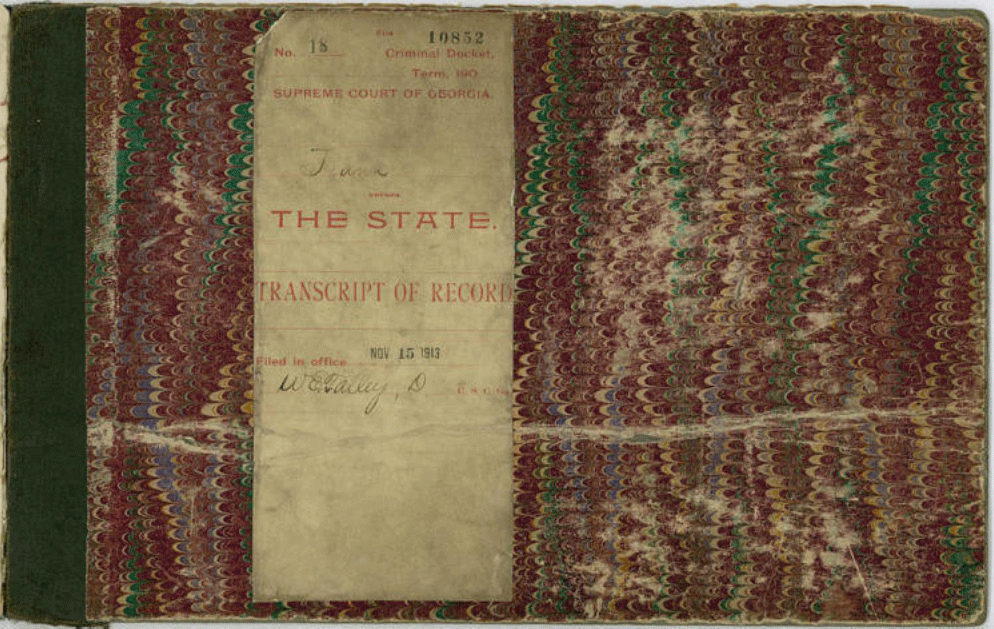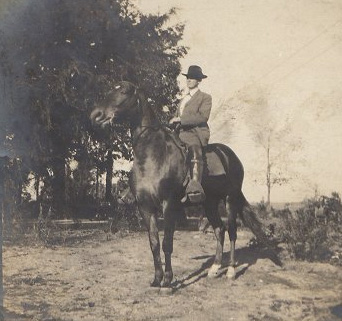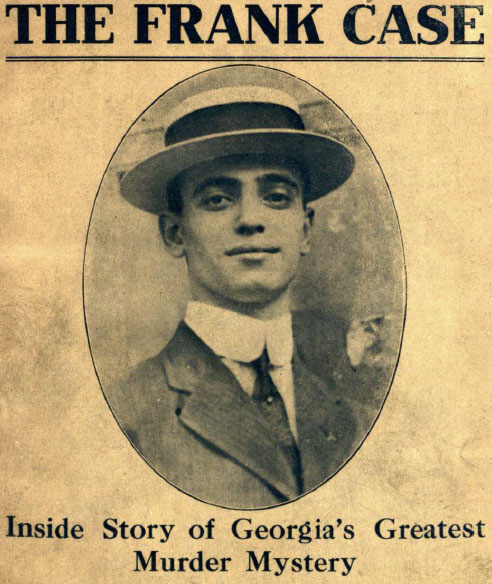John de Nugent Presents: The 2015 created centennial audiobook of a 1915 magazine article written and published in 1915 by then future U.S. Senator from Georgia (1920-1922), Tom Watson (September 5, 1856 – September 26, 1922), called “The Official Record in the Case of Leo Frank, a Jew Pervert” originally published in Watson’s Magazine, September 1915, less than 2 weeks after the Leo Frank lynching on August 17, 1915. We are pleased to present this text booklet transformed into a radio program 100 years later for you, with commentary.
Click to play here: [sc_embed_player fileurl=”http://leofrank.org/audio_books/de_nugent/Tom%20Watson%20-%20Leo%20Frank%20Jew%20Pervert%20Sept%201915%20-%20read%20by%20John%20de%20Nugent.mp3″]
* * *
National Vanguard Presents:
EDITOR’S NOTE: National Vanguard now makes available this, the fourth audio book from Tom Watson’s series on the Leo Frank case, read by Vanessa Neubauer (without commentary).
* * *
An audiobook version of ‘The Official Record in the Case of Leo Frank, a Jew Pervert’ (Watson’s Magazine, September 1915) with commentary and analysis by Alex Linder from the VNN Free Learning College (Centennial, 2015) is available for your listening pleasure.
* * *
Omniphi Media Presents:
‘The Official Record in the Case of Leo Frank, a Jew Pervert’ by Tom Watson Published in Watson’s Magazine, September 1915, transformed in 2015 into audiobook by Oscar Turner of Omniphi Media (without commentary about text).
Introductory Notes from National Vanguard (2015):
Eventually, all of Watson’s long-suppressed essays on the Frank case will be available in audio format, in time for 100th anniversary of Leo Frank’s death in 1915. As the reader for this series, Vanessa Neubauer, states: “It’s important that Watson’s work get out there into the public eye this year, because he’s a major — yet suppressed — author on the Leo Frank case. Leo Frank was a Jewish factory owner who was convicted of the sex murder of a teenage White girl, Mary Phagan, who worked in his sweatshop. His arrest, conviction, and eventual lynching was the impetus for the founding of the Jewish ADL. The Jews will be making a major media push, climaxing this August on the 100th anniversary of Frank’s death, to convince the public that Frank was innocent. We need to counter all that, and tell the truth to give some sort of justice to Mary Phagan and her family. And the facts are on our side.”
* * *
The Official Record in the Case of Leo Frank, a Jew Pervert by Thomas E. Watson (pictured), Watson’s Magazine, Volume 21 Number 5, September 1915.
IN NEW YORK, there lived a fashionable architect, whose work commanded high prices. He was robust, full of manly vigor, and so erotic that he neglected a handsome and refined young wife to run after little girls.
As reported in the papers of William R. Hearst, Joseph Pulitzer, and Adolph Ochs, the libertine architect had three luxurious suites of rooms fitted up for the use of himself, a congenial company of young rakes, and the young women whom they lured into these elegant dens of vice.
Stanford White’s principal place, however, was in the tower-apartments of Madison Square Garden. In this building, his preparations for sensual and sexual enjoyment were as carefully elaborated and as expensively perfected, as though wine, women and song were the chief end of man’s existence. The excavations at Pompeii have revealed no Rose-door voluptuousness more Oriental than that of Stanford White. Like the Roman sensualist who stimulated his amorous passions by surroundings that promoted desire and prolonged the pleasure, White was artistic in his vices; and it was the nude girl, of perfect symmetry and beautiful face, that he bore into his seraglio, where rich and splendid appointments, soft lights, hidden musical instruments, fragrant flowers, and choice wines intoxicated every sense to the highest pitch of epicurean ecstasy.
Into this golden harem, he took the young, lovely and unmoral Evelyn Nesbit; and, according to her statement, she was brutally used. A shocking fact in the case is, that White seems to have given money to the girl’s mother, and that the mother had, in effect, surrendered the maid to the man—knowing why he wanted her.
Whatever the girl felt as to the manner in which White had accomplished his purpose, she soon afterwards returned to him, and their relations continued for some months. Then Harry Thaw happened to see her, fell in love with her, and desired so ardently to possess her, that he married her.
They went to Europe, and during the tour, the wife told the young husband her terrible story. On their return to New York, the architect had the insane folly to again enter into correspondence with Evelyn—this time knowing that he had an excitable young man to encounter—a husband who might be supposed to have learned his wife’s secret. All the world knows how Thaw was inflamed beyond bounds, by seeing White sitting in the eating-room, at the Garden; and how the young husband immediately shot the satyr who had doped and ruined his wife.
The great legal battle that Thaw’s devoted mother has waged in her boy’s behalf, is a part of the history of the times. For nine long years, that fine old woman has borne her cross, and made her fight, her son behind the bars, all those bitter years.
At last, after nine years of imprisonment, Harry Thaw is a free man—for the court which tried him for murder, pronounced him insane; and the jury which recently tried him for insanity, said that he is sane.
At least one of these verdicts was correct, and both may have been; but the jurors in the last trial have since declared that Thaw ought to have killed White, anyway; and about three-fourths of the red-blooded men and women of the country are of the same opinion.
But the Jew-owned papers, and the Jew-hired papers, and the Hearst papers take a different view. They are outraged. Their feelings are deeply hurt. They lament the failure of the Law to hang this hot-tempered boy who shot the man that had virtually bought Evelyn from her monstrous mother, and had then drugged and forced her. In their wrathful eyes, nine years’ imprisonment is no punishment at all. They rail at the influence of Money, and deplore the disgrace which has fallen upon New York—the righteous town where Jacob Schiff, the banker, could give a forty-year sentence to an humble Jew, for entering clandestinely the dwelling of a Jewish millionaire; the righteous town wherein the Roman priests could have the Mayor assassinated without provoking hostile comment from the Hearst papers, the Jew-owned papers, or the Jew-hired papers; the righteous town where the priest, Hans Schmidt, can cut his concubine’s throat, dismember her body, fling the pieces in the river, and still escape punishment!
Let us regale our minds by reading what the Hearst papers say about the case of Harry Thaw:
It is quite true that but for the lavish outpouring of the family fortune, Thaw might have been electrocuted, or would still be confined in a madhouse. It is equally true that but for the contributions of other rich young men, whose money cursed them, his fight for liberty would not have been so prolonged or so costly.
Many will moralize over the power of money as manifested in the escape of Thaw from paying the extreme penalty for the murder of Stanford White.
Fewer will stop to think of the malign power of money that pressed this rich young man along the primrose path that ended in the murder on the roof garden, his prolonged imprisonment, and the ineradicable disgrace which rests upon his name.
As it is, about the most the public can say of him is to express the hope that the public mind shall not longer be assailed by the fulminations of spectacular lawyers, the imaginings of alienists, and the bathos of hired pamphleteers. The world is weary of Thaw.
The world is not weary of Hearst, fortunately; and if he can explain his prolonged hostility to Thaw, and reconcile it with his determined championship of Frank, the world will peruse his statement with interest.
Let us now read what another New York paper—Jew-owned or Jew-hired—published about the two cases, Frank’s and Thaw’s. Concerning Thaw, the New Republic says:
In the case of Harry K. Thaw, it looks as if the State of New York had thoroughly well got its leg pulled. The State deserved it richly, for it asked a judge and a jury to decide a question which they are simply incapable of deciding. Those laymen could no more pass on Thaw’s sanity than upon the condition of his liver. Thus a man may be highly educated, courteous, genial in every relation of life, and still bear within him a murderous disposition, which breaks out only on special occasions. The voluble juryman who has been so much interviewed came pretty close to the truth when he said that Thaw would never kill except when a woman was involved.
What freed Thaw was in reality a combination of prejudices. He behaved well in court. The State’s alienists behaved badly in court. Thaw fought a long fight, and men admire persistence. He had murdered Stanford White, a man who happened to be a genius, but whose genius was forgotten in the deep moral prejudice against him. The brutal fact is that an American jury is very ready to flirt with the idea that there are unwritten laws to justify the killing of men who seduce young girls.
Concerning the Frank case, the same New York paper says:
It is often too foolish to indict a whole people. But in this instance the guilt of the people is clear. They wrecked the only trial Frank has had, they believed every lie about him, they terrorized their public officials. They have made democracy hideous—they, the men and women of the State. There was a minority that knew better, a minority that did not wish to make the courts of the State a vile spectacle to the whole nation. But of that minority many were too cowardly to speak out. They allowed the mob to stamp its own imprint upon the public character of the State. The Governor who acted, and the opinion which supported him, were not enough to save Georgia from its degradation.
A people which cannot preserve its legal fabric from violence is unfit for self-government. It belongs in the category of communities like Haiti, communities which have to be supervised and protected by more civilized powers. Georgia is in that humiliating position today. If the Frank case is evidence of Georgia’s political development, then Georgia deserves to be known as the black sheep of the American Union.
It is a disagreeable discovery of the New Republic, that American juries harbor a perverse sympathy for fathers and brothers who kill the seducers of young girls, and thus rid the earth of the most dangerous vipers that crawl. The New Republic says that it is not only a fact that juries do sympathize with the men who give shot-gun protection to womanhood, but that this fact is brutal.
When the human race ceases to be capable of brutality of that sort, civilization will be the soup-kettle of molly-coddles; and literature will degenerate into a milk-sop effeminacy that won’t be worth hell’s room.
Coming to the Frank case, the New Republic condemns, not only the jury and the judges, but the whole State in which the horrible crime was committed. “It is often foolish to indict a whole people,” says this magazine. Edmund Burke said it was always foolish to do so.
The State of Georgia, as a whole, is pronounced guilty. It has had no evidence against Frank; it has been possessed of a Devil of blind hatred; it has relentlessly persecuted; it has tried to lynch an innocent man, under legal forms. Its mobs terrified the witnesses; terrified the jurors; terrified the trial judge; terrified the Supreme Court of Georgia in both of its decisions, the last of which was unanimous. Finally, the Georgia mobs terrified the Supreme Court of the United States, which, under duress, decided that Frank’s lawyers—after having had all the time, money and opportunity needed—had utterly failed to show that Georgia had not given to Leo Frank every right to which he was entitled. Continue Reading →

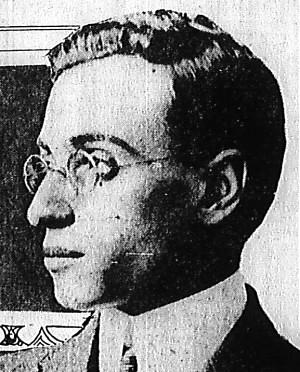
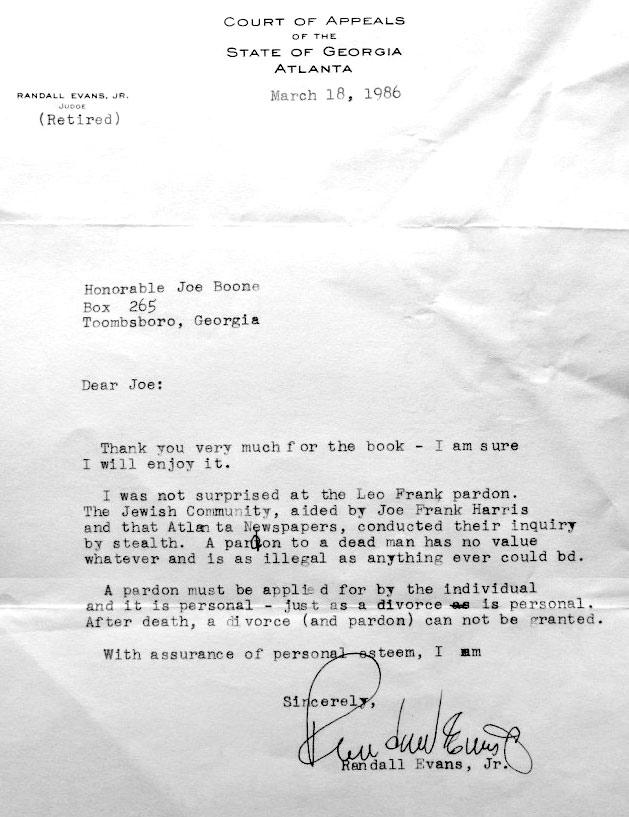

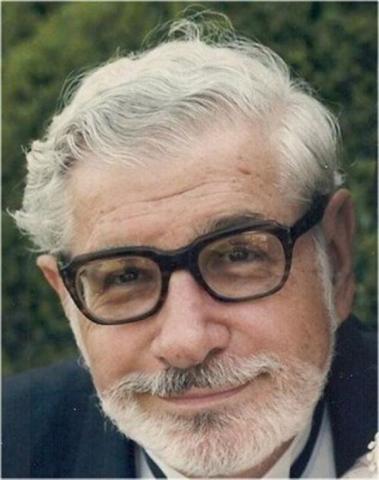 Said Bill Nigut, the ADL’s southeast regional director:
Said Bill Nigut, the ADL’s southeast regional director: 


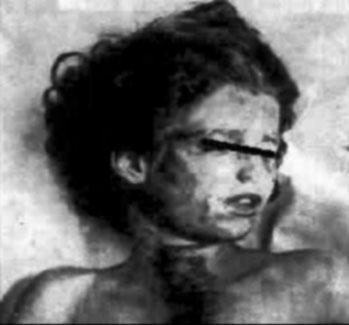





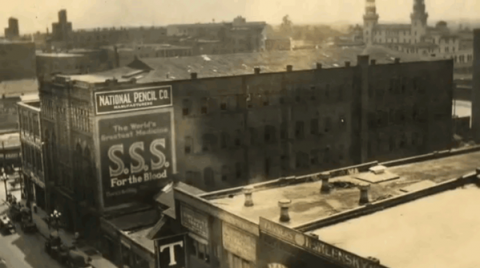
 Rabbi Lebow is very active in the cause of Leo Frank, and says of the pardon, “That’s not enough.” He wants Frank to be declared innocent and will ask the Georgia General Assembly, Cobb County and the city of Marietta to exonerate Frank.
Rabbi Lebow is very active in the cause of Leo Frank, and says of the pardon, “That’s not enough.” He wants Frank to be declared innocent and will ask the Georgia General Assembly, Cobb County and the city of Marietta to exonerate Frank. 



